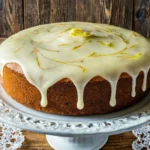Description
Step 1: Sift the Powdered Sugar
Sift your powdered sugar into the medium mixing bowl. This step is optional but helps prevent clumps in your glaze, ensuring a smooth consistency.
Step 2: Add Lemon Juice
Add 2 tablespoons of fresh lemon juice to the sifted powdered sugar. If you desire a thinner consistency, you’re welcome to add more lemon juice later on.
Step 3: Whisk Together
Whisk the mixture vigorously until fully combined. Ensure that there are no lumps and the glaze is smooth. If the mixture seems too thick, add more lemon juice, one teaspoon at a time, until you achieve your desired consistency. For a thicker glaze, you can add a bit more powdered sugar until it reaches the thickness you like.
Step 4: Adjust Consistency
Adjust the glaze to your liking. The beauty of lemon glaze lies in its simplicity and adaptability. Whether you prefer a thick glaze to spread with a knife or a thinner one to drizzle with a spoon, you can easily adjust the thickness by playing with the amount of lemon juice.
Step 5: Apply the Glaze
Drizzle or spread the glaze over your cooled baked goods. This is where you get to be creative — use a spoon to drizzle it over cakes, muffins, scones, or cookies, or use a pastry brush for a more even coating. Remember, the baked goods should be at room temperature to prevent the glaze from melting.
Step 6: Let It Set
Allow the glaze to set. After applying the glaze, give it some time to harden slightly on the surface of your desserts. This usually takes about 15-20 minutes at room temperature.
Step 7: Serve and Enjoy
Serve your glazed treats. Once the glaze has set, your desserts are ready to be enjoyed! Lemon glaze adds a lovely zesty flavor and decorative touch to your baking creations.
Ingredients
Ingredients:
1 cup powdered sugar (also known as confectioners’ sugar)
2 to 3 tablespoons fresh lemon juice
Equipment:
Medium mixing bowl
Whisk
Sifter (optional, but recommended for smoother glaze)
Instructions
Sift your powdered sugar into the medium mixing bowl. This step is optional but helps prevent clumps in your glaze, ensuring a smooth consistency.
Add 2 tablespoons of fresh lemon juice to the sifted powdered sugar. If you desire a thinner consistency, you’re welcome to add more lemon juice later on.
Whisk the mixture vigorously until fully combined. Ensure that there are no lumps and the glaze is smooth. If the mixture seems too thick, add more lemon juice, one teaspoon at a time, until you achieve your desired consistency. For a thicker glaze, you can add a bit more powdered sugar until it reaches the thickness you like.
Adjust the glaze to your liking. The beauty of lemon glaze lies in its simplicity and adaptability. Whether you prefer a thick glaze to spread with a knife or a thinner one to drizzle with a spoon, you can easily adjust the thickness by playing with the amount of lemon juice.
Drizzle or spread the glaze over your cooled baked goods. This is where you get to be creative — use a spoon to drizzle it over cakes, muffins, scones, or cookies, or use a pastry brush for a more even coating. Remember, the baked goods should be at room temperature to prevent the glaze from melting.
Allow the glaze to set. After applying the glaze, give it some time to harden slightly on the surface of your desserts. This usually takes about 15-20 minutes at room temperature.
Serve your glazed treats. Once the glaze has set, your desserts are ready to be enjoyed! Lemon glaze adds a lovely zesty flavor and decorative touch to your baking creations.
- Prep Time: 5 minutes
- Cook Time: 0 minutes
- Category: FRUITS
- Method: No Bake
- Cuisine: International
Nutrition
- Serving Size: 2 tablespoons
- Calories: 100 calories
- Sugar: 25 grams
- Sodium: 0 mg
- Fat: 100 calories
- Saturated Fat: 25 grams
- Unsaturated Fat: 0 mg
- Trans Fat: 0 grams
- Carbohydrates: 25 grams
- Fiber: 0 grams
- Protein: 0 grams
- Cholesterol: 0 grams
Keywords: What is lemon glaze made of?, Ingredients in lemon glaze, Lemon glaze recipe components, Making lemon glaze, Lemon glaze essentials
